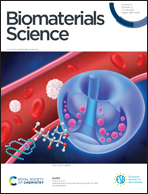Cytosolic delivery of gadolinium via photoporation enables improved in vivo magnetic resonance imaging of cancer cells†
Abstract
Longitudinal in vivo monitoring of transplanted cells is crucial to perform cancer research or to assess the treatment outcome of cell-based therapies. While several bio-imaging techniques can be used, magnetic resonance imaging (MRI) clearly stands out in terms of high spatial resolution and excellent soft-tissue contrast. However, MRI suffers from low sensitivity, requiring cells to be labeled with high concentrations of contrast agents. An interesting option is to label cells with clinically approved gadolinium chelates which generate a hyperintense MR signal. However, spontaneous uptake of the label via pinocytosis results in its endosomal sequestration, leading to quenching of the T1-weighted relaxation. To avoid this quenching effect, delivery of gadolinium chelates directly into the cytosol via electroporation or hypotonic cell swelling have been proposed. However, these methods are also accompanied by several drawbacks such as a high cytotoxicity, and changes in gene expression and phenotype. Here, we demonstrate that nanoparticle-sensitized laser induced photoporation forms an attractive alternative to efficiently deliver the contrast agent gadobutrol into the cytosol of both HeLa and SK-OV-3 IP1 cells. After intracellular delivery by photoporation the quenching effect is clearly avoided, leading to a strong increase in the hyperintense T1-weighted MR signal. Moreover, when compared to nucleofection as a state-of-the-art electroporation platform, photoporation has much less impact on cell viability, which is extremely important for reliable cell tracking studies. Additional experiments confirm that photoporation does not induce any change in the long-term viability or the migratory capacity of the cells. Finally, we show that gadolinium ‘labeled’ SK-OV-3 IP1 cells can be imaged in vivo by MRI with high soft-tissue contrast and spatial resolution, revealing indications of potential tumor invasion or angiogenesis.



 Please wait while we load your content...
Please wait while we load your content...